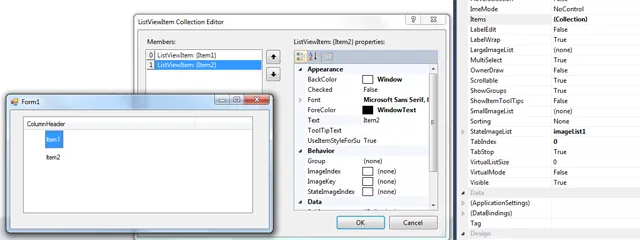我想要改变ListView中每个选项的行高度。
我已经搜索了很多地方,发现要改变高度,需要使用LBS_OWNERDRAWFIXED或MeasureItem之类的方法。
问题是我不知道具体该怎么做和如何使用它。
有人能帮帮我吗?
编辑:
我不能使用ImageList技巧,因为我实际上正在使用SmallImageList,并且我需要与ImageList图像大小不同的行高。
谢谢!
我想要改变ListView中每个选项的行高度。
我已经搜索了很多地方,发现要改变高度,需要使用LBS_OWNERDRAWFIXED或MeasureItem之类的方法。
问题是我不知道具体该怎么做和如何使用它。
有人能帮帮我吗?
编辑:
我不能使用ImageList技巧,因为我实际上正在使用SmallImageList,并且我需要与ImageList图像大小不同的行高。
谢谢!
对于仍然苦恼的人,这是我使用的代码:
private void SetHeight(ListView listView, int height)
{
ImageList imgList = new ImageList();
imgList.ImageSize = new Size(1, height);
listView.SmallImageList = imgList;
}
要使用它,只需执行以下操作:
SetHeight(lvConnections, 25);

可以使用 SmallImageList 技巧来实现 - 你只需要小心一些。 ObjectListView -- 一个基于标准 .NET ListView 的开源封装 -- 使用此技巧成功实现了 RowHeight 属性。
如果你希望每行有32像素,就要分配一个16x32(宽x高)的 ImageList,然后将每个图像放置在32像素高度的垂直中间。
以下屏幕截图显示了32像素行和由于额外的空间而可能的换行:

ObjectListView 为您完成所有这些工作。事实上,如果您正在尝试对ListView进行任何操作,应该严肃考虑使用 ObjectListView。 它使许多困难的事情(例如按列类型排序,自定义工具提示)变得微不足道,并使一些不可能的事情(例如覆盖,虚拟列表上的分组)成为可能。
LBS_OWNERDRAWFIXED的问题。using System;
using System.Drawing;
using System.Diagnostics;
using System.ComponentModel;
using System.Runtime.InteropServices;
using System.Windows.Forms;
namespace ExtendedControls
{
public class ListViewEx : ListView
{
#region Windows API
/*
struct MEASUREITEMSTRUCT
{
public int CtlType; // Offset = 0
public int CtlID; // Offset = 1
public int itemID; // Offset = 2
public int itemWidth; // Offset = 3
public int itemHeight; // Offset = 4
public IntPtr itemData;
}
*/
[StructLayout(LayoutKind.Sequential)]
struct DRAWITEMSTRUCT
{
public int ctlType;
public int ctlID;
public int itemID;
public int itemAction;
public int itemState;
public IntPtr hWndItem;
public IntPtr hDC;
public int rcLeft;
public int rcTop;
public int rcRight;
public int rcBottom;
public IntPtr itemData;
}
// LVS_OWNERDRAWFIXED: The owner window can paint ListView items in report view.
// The ListView control sends a WM_DRAWITEM message to paint each item. It does not send separate messages for each subitem.
const int LVS_OWNERDRAWFIXED = 0x0400;
const int WM_SHOWWINDOW = 0x0018;
const int WM_DRAWITEM = 0x002B;
const int WM_MEASUREITEM = 0x002C;
const int WM_REFLECT = 0x2000;
#endregion
bool mb_Measured = false;
int ms32_RowHeight = 14;
/// <summary>
/// Constructor
/// </summary>
public ListViewEx()
{
SetStyle(ControlStyles.OptimizedDoubleBuffer | ControlStyles.AllPaintingInWmPaint, true);
}
/// <summary>
/// Sets the row height in Details view
/// This property appears in the Visual Studio Form Designer
/// </summary>
[Category("Appearance")]
[Description("Sets the height of the ListView rows in Details view in pixels.")]
public int RowHeight
{
get { return ms32_RowHeight; }
set
{
if (!DesignMode) Debug.Assert(mb_Measured == false, "RowHeight must be set before ListViewEx is created.");
ms32_RowHeight = value;
}
}
protected override CreateParams CreateParams
{
get
{
CreateParams k_Params = base.CreateParams;
k_Params.Style |= LVS_OWNERDRAWFIXED;
return k_Params;
}
}
/// <summary>
/// The messages WM_MEASUREITEM and WM_DRAWITEM are sent to the parent control rather than to the ListView itself.
/// They come here as WM_REFLECT + WM_MEASUREITEM and WM_REFLECT + WM_DRAWITEM
/// They are sent from Control.WmOwnerDraw() --> Control.ReflectMessageInternal()
/// </summary>
protected override void WndProc(ref Message k_Msg)
{
base.WndProc(ref k_Msg); // FIRST
switch (k_Msg.Msg)
{
case WM_SHOWWINDOW: // called when the ListView becomes visible
{
Debug.Assert(View == View.Details, "ListViewEx supports only Details view");
Debug.Assert(OwnerDraw == false, "In ListViewEx do not set OwnerDraw = true");
break;
}
case WM_REFLECT + WM_MEASUREITEM: // called once when the ListView is created, but only in Details view
{
mb_Measured = true;
// Overwrite itemHeight, which is the fifth integer in MEASUREITEMSTRUCT
Marshal.WriteInt32(k_Msg.LParam + 4 * sizeof(int), ms32_RowHeight);
k_Msg.Result = (IntPtr)1;
break;
}
case WM_REFLECT + WM_DRAWITEM: // called for each ListViewItem to be drawn
{
DRAWITEMSTRUCT k_Draw = (DRAWITEMSTRUCT) k_Msg.GetLParam(typeof(DRAWITEMSTRUCT));
using (Graphics i_Graph = Graphics.FromHdc(k_Draw.hDC))
{
ListViewItem i_Item = Items[k_Draw.itemID];
Color c_BackColor = i_Item.BackColor;
if (i_Item.Selected) c_BackColor = SystemColors.Highlight;
if (!Enabled) c_BackColor = SystemColors.Control;
using (SolidBrush i_BackBrush = new SolidBrush(c_BackColor))
{
// Erase the background of the entire row
i_Graph.FillRectangle(i_BackBrush, i_Item.Bounds);
}
for (int S=0; S<i_Item.SubItems.Count; S++)
{
ListViewItem.ListViewSubItem i_SubItem = i_Item.SubItems[S];
// i_Item.SubItems[0].Bounds contains the entire row, rather than the first column only.
Rectangle k_Bounds = (S>0) ? i_SubItem.Bounds : i_Item.GetBounds(ItemBoundsPortion.Label);
// You can use i_Item.ForeColor instead of i_SubItem.ForeColor to get the same behaviour as without OwnerDraw
Color c_ForeColor = i_SubItem.ForeColor;
if (i_Item.Selected) c_ForeColor = SystemColors.HighlightText;
if (!Enabled) c_ForeColor = SystemColors.ControlText;
TextFormatFlags e_Flags = TextFormatFlags.NoPrefix | TextFormatFlags.EndEllipsis | TextFormatFlags.VerticalCenter | TextFormatFlags.SingleLine;
switch (Columns[S].TextAlign)
{
case HorizontalAlignment.Center: e_Flags |= TextFormatFlags.HorizontalCenter; break;
case HorizontalAlignment.Right: e_Flags |= TextFormatFlags.Right; break;
}
TextRenderer.DrawText(i_Graph, i_SubItem.Text, i_SubItem.Font, k_Bounds, c_ForeColor, e_Flags);
}
}
break;
}
}
}
} // class
} // namespace
listviewitem.UseItemStyleForSubItems属性,因此不会绘制。如果将该属性设置为false,则需要绘制子项的背景颜色。请建议如何实现相同的效果。 - JDoshiPrivate Font stdfont = new Font( "Consolas", 9.0f, FontStyle.Regular );
接着当添加项目时:
ListViewItem i = new ListViewItem( "some text" );
i.Font = stdfont;
MyListView.Items.Add( i );
Plasmabubble有正确的想法。这个扩展了它,是我用来使用窄线宽的项目。
ListView中的行间距取决于ListView的字体,无法更改。但是,您可以将ListView中的项目字体设置为大于ListView的字体。
如果您希望其成比例,请基于项目字体创建字体。 我希望项目高度为正常值的90%,无论选择哪种字体。
当我填充列表时,我使用存储在设置中的字体,但也可以使用像“Consolas”这样的文字字体。
lvResults.Font =
new Font(Properties.Settings.Default.usrHookFont.FontFamily,
(float)(Properties.Settings.Default.usrHookFont.Size * .9));
foreach (HookSet item in resultSet)
{
ListViewItem lvi = new ListViewItem();
lvi.Font = Properties.Settings.Default.usrHookFont;
<dot><dot><dot>
}
阅读了这么多年的答案后,有两种方法可以使用基于ListView的扩展控件,另一种是使用字体或图标进行扩展。 如果您的项目已经使用了ListView - 就像我的情况一样,您需要在保持原始图标和字体大小的同时扩展列高度 - 我建议 您可以大致计算所需的列高度和正常图标大小的比例,因此使用透明边框来扩展图标大小,例如,如果24x24图标实际上高度为35,则可以使用Windows Paint 3D将图标扩展到35x35,使用画布保持图标的原始比例,我认为这可能是最省时和成本效益的方法。